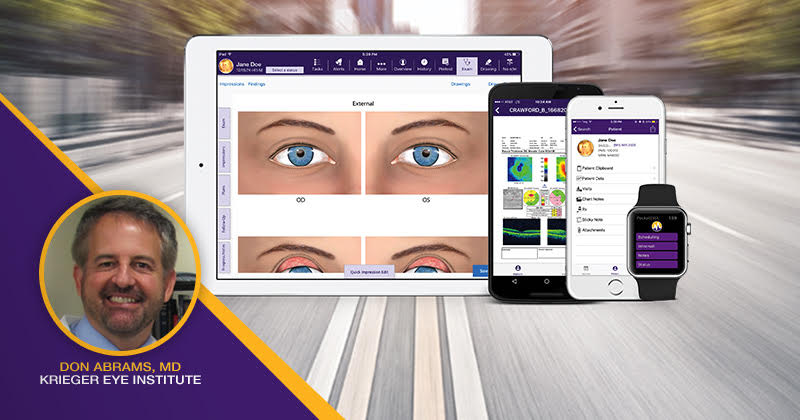Why and How to Switch EMR System Vendors

When our old system cut productivity, we found a new one to boost it
This article was sponsored by Modernizing Medicine. Read the original article published in Ophthalmology Management here.
The road to finding the right EMR for our hospital’s department of ophthalmology has been bumpy. We went from paper to EMR, then back to paper—before finally finding the right EMR for our needs.
Our initial mistake was choosing an EMR system that was purchased and adopted by our large health system. We quickly realized that the system did not complement our work in ophthalmology. Thankfully, our hospital listened, acknowledged the problem, and allowed us to return to paper until we found a solution that fit our needs.
The Wrong Fit: Productivity Drain
Our hospital system adopted a major EMR platform in 2007. It wasn’t a natural fit for the department of ophthalmology, so we spent the better part of a year customizing templates and designing the ways we would interact with the system.
Finally, we deployed the EMR in ophthalmology. We lowered our planned productivity to 25% temporarily to give everyone an opportunity to get used to it; however, in the 6 weeks that followed, productivity never rose much beyond that 25% level. Even with all of our customization, the EMR was cumbersome and time-consuming. It also interfered with patient care, forcing doctors to interact with laptop and desktop computers instead of patients.
We ended up with disgruntled physicians, bad patient flow, and one faculty member’s resignation on my desk. In a short amount of time, the EMR system created an atmosphere of generalized misery. We saw that it wasn’t going to work, so we stopped in our tracks and went back to paper. Yes, some ophthalmologists hang in there and get used to an EMR that “works OK,” but we didn’t want to get used to “OK.”
After 5 years of browsing other EMRs, I was given the go-ahead to search for our own system that would interface with the larger EMR. One caveat: Try the health system’s EMR again, with help from the vendor, to see if updates had prepared it to handle ophthalmology. The old EMR was actually worse for us than before, so the search began in earnest for a new vendor.
The Right Fit: Increased Efficiency
During our search, we found EMA for ophthalmology from Modernizing Medicine, which has all the features we wanted. First, EMA is a cloud-based mobile platform, so our physicians, technicians, and scribes can all use iPads, while only staff in administrative roles use desktop computers. Instead of turning away to type into a laptop, we can chart while maintaining our connection with patients. We also use the iPad to educate patients, sharing images and graphics of the disease process with ease. Our staff prefers this shared-device approach — and our patients appreciate the uninterrupted visits.
The EMA platform is designed from the ground up for ophthalmologists, so data input and retrieval are already optimized for efficiency in our world. There’s also no signing in and out a hundred times a day — only once in the morning.
We took part in an online demo of EMA, an on-site meeting at Modernizing Medicine, and in a few weeks, the contracts were signed. Modernizing Medicine’s training model was unique and efficient, with a mix of self-directed and group learning. We went live with EMA after just 6 weeks, compared to nearly a year with the other EMR.
Worth the Wait
Six weeks after implementation, the department of ophthalmology reached 108% productivity. We were actually more productive with EMA than with paper charts (not to mention that all of our charts were now legible). The rollout goal was to use a mix of EMA and paper, but within a couple of days, most of our doctors didn’t want to use paper anymore. Thus, adoption was very rapid — much faster and easier than we imagined.
About a year later, we added an image management system integrated with EMA, which has been great. We continue to be very enthusiastic about the EMA platform and pleased that we decided to look beyond “OK” to find an EMR vendor that truly supports our work.





